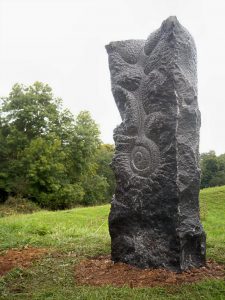
Through a stone company in Dorset, I ordered a 6ft by 2ft by 1ft lump of Kilkenny stone from Ireland, so called Celtic Stone.
The delivery lorry refused to drive up the track, a kindly neighbouring farmer accommodated the block in his yard, then brought it over with one of those massive tractors. I had dug a shallow pit in the turning place, just up from the steps leading down to our house, we planted it, perhaps 1 foot down and secured it with rocks.
I wanted to be able to carve it in all weathers and constructed a plastic bender around it. This was basically four posts, perhaps 5ft high, which supported a dome made of bent hazel branches. These were lashed together with string and wire and then covered with two overlapping sheets of builder’s plastic. I borrowed a wood-burning stove, ran a cable for lights to it from the house and was ready to start.
I had made a clay and a limestone model on the theme of Birth and Rebirth, let’s say they inspired me, but did not limit me. In the actual piece, Birth became like a river of life, streaming between rocks and rushing into a spiral shape. Rebirth implied a figure, angel-like, spreading its wings and emerging out of the rock.
I had never carved Kilkenny stone before and took a short time to get acquainted. It was if anything, harder than the Thassos marble, but somehow and miraculously, I got into the right mode quite quickly. Like the marble, I had to use tungsten tips, but unlike the marble, broke not a single tool. It was a half sawn block, in other words, two surfaces were cut, and two surfaces were rough and natural. I started with the ‘Birth’ theme, working on the rough back face. The contours and craggy bits began to speak to me; I worked with what was there. Obviously, I had immersed myself in the substance of stone before but never with the configurations of its outer surfaces. It really was like having a conversation, I could describe it as a feminine way of working, I had to be sensitive, open, receptive, holding back, allowing the stone to speak. The other side, the cut surface was quite different. It was all masculine, the imposing of the will, the clear and careful execution of a design.
The other thing that began to dawn, was a growing awareness of the spiritualisation of matter. The visiting older boy in Thornbury had once talked about this, many, many years ago; how elemental beings are freed from the stone when you work it. I did not see any elemental beings, but had the strong impression that something was being freed, that I was engaged in a powerful process of transformation. It was almost as if the reduction of the mass of stone, a kind of dyeing away of material, was actually changing it into energy. It also became a kind of memorial for me, I poured my grief and loss into it.
The sculpture was eventually placed on a little grassy hill in a field in Horsley, a place he used to visit with his friends.
